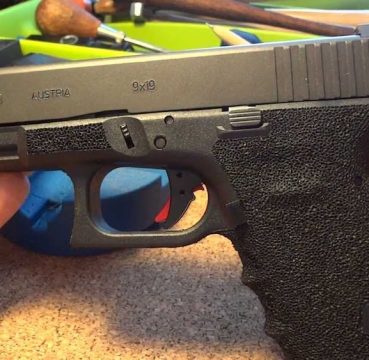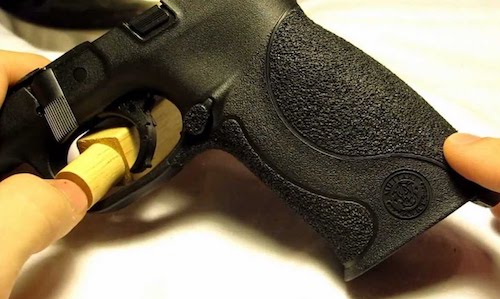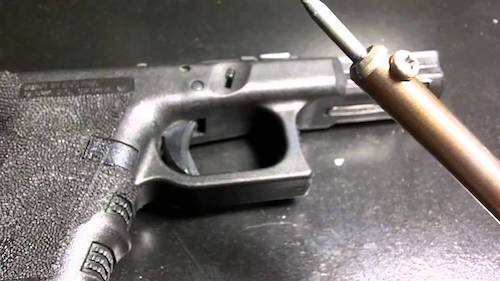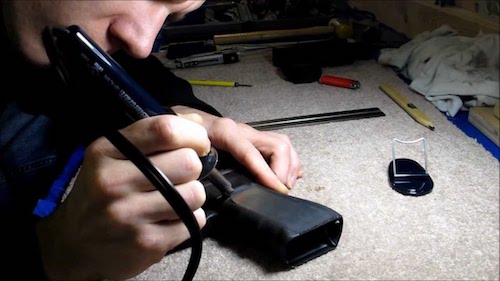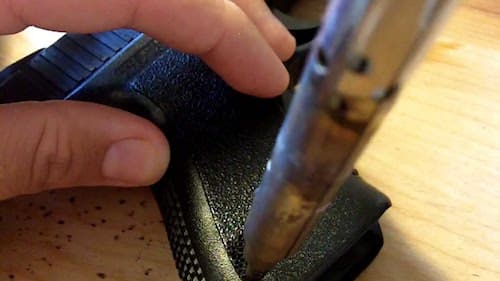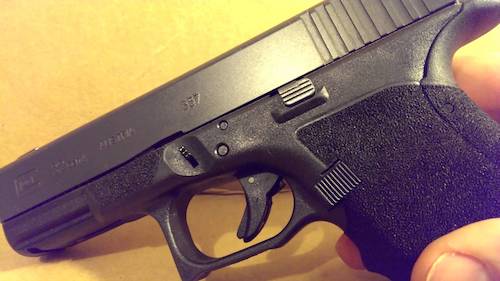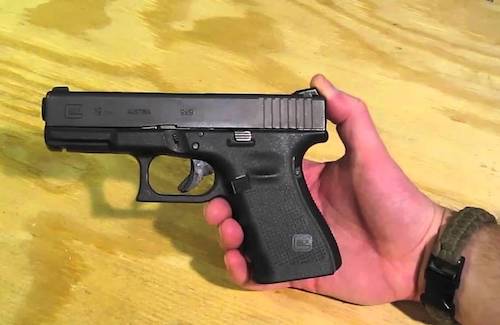In this article, we are going to be talking about stippling a Glock handgun. We will be looking at what stippling is, how it’s beneficial, and lastly, you will learn how to stipple a Glock on your own. And best of all, I am going to tell you how to do it with just a few basic tools that you probably already have laying around somewhere in the garage.
So grab you fireproof gloves, your range bag, and pistol, and let’s head out to the workshop learn how to stipple a Glock.
Table Of Contents
Why You Should Stipple A Glock or Any Handgun?
Stippling your pistol can be beneficial to the comfort level of your pistol grip, but it also gives the handle of your pistol much better traction than it probably had when you pulled it fresh out of the box.
And while you can stipple just about any handgun, Glocks are the ones that you may find need it the most.
Now, don’t get me wrong, I absolutely love my Glock 23, but I have never personally cared much for their grips. Since they are made of a polymer material, my hands are constantly slipping across the handle when even a minimal amount of sweat is present. Obviously, this is not what you want to happen while you are firing off shots at the shooting range.
Stippling remedies this problem. When you stipple your handgun grips, you are essentially just using your soldering iron to melt small holes onto the polymer handle. But when you have tons of them altogether, it gives your grip a feel that is more similar to something gritty like sandpaper.
How to Stipple A Glock – Getting Started
Stippling your handgun is not only surprisingly easy once you get the hang of it but it also only requires just one tool: a decent soldering iron or a wood burning tool.
We recommend using a soldering iron that features a way for you to adjust the temperature. Since Glock grips are made of a polymer material, it is extremely easy to burn straight through them if your heat is set too high.
One of the best soldering irons on the market right now and one that we really like for stippling projects is the Weller WES51 Analog Soldering Station. It has adjustable temperature settings and a slim soldering pencil that’s perfect for stippling smaller holes and around sensitive edges.
Pick up one for yourself and let’s start stippling.
Step 1: Start with the outlines
The easiest way to make sure that you stippling job comes out looking professionally done is to start with the outlines. This is the hardest part of this entire process in my opinion, but it is also the one that will leave your Glock looking better than when you bought it, if you do it right.
To start the outlining, you first want to get an idea of where you want the stippling to begin and end. Take into consideration any bumps, grooves, buttons, or other indentations you will have to work around or through as you go along.
When you have an idea of how big of an area you want to stipple, what shape it will be, and what areas you will be working on, it’s time to heat up the soldering iron.
Now, let me tell you something very important before you read any further. Soldering irons can get as hot as 600 degrees or more. They will melt straight through soft polymer like a hot knife through butter, and that Glock grip that you will be stippling is made of a soft polymer.
You need to be very gentle and lightly tap your soldering iron on the grip to make a hole. The longer you leave it there, the bigger the hole will be, and it only takes a few seconds of contact for the soldering iron to go straight through the plastic and ruin your grip forever.
Marking Your Glock
While your soldering iron is heating up, you can go ahead and start marking where your outline should be placed. I personally like using some masking tape for this. Not only will the masking tape give you a bit of a guide to follow, but if you place your dots right up against the edge of the masking tape you can also get nearly perfect straight lines with little effort.
With your outline edges marked and your soldering iron ready to be put to work, time to jump into the fun stuff.
To begin, simply follow along with the edges of your outline, tapping the soldering iron onto the grip gently and only tapping it for just a brief second. Every time you tap the grip with the tip of your iron, try to place the tip down so that it touches the edge of your last dot.
Continue this process until the area that you are going to be stippling is outlined in small uniform dots.
Step 2: Fill in your outlined areas
Once you outlining work is complete, it is time to move to the next step of the process which is filling in the area that you have just outlined.
This part is easy and shouldn’t take you much time at all. Basically, all you will be doing in this step is just repeating what you did with the outline to create the small dots, except the ones that you will be making to fill in the grip area do not need to be lined up perfectly. I mean, you can if you really want to, and it would look nice, but it would take quite some time to accomplish by hand.
Just start applying dots inside your outlined area until it is filled up completely with melted-in dots. Unless you are going for a specific custom design, you want so many dots that you can’t see the original grip anymore.
Now that you have all your dots melted in, go through and do some small touch-ups to make sure everything is aesthetically appealing. Check for spots that you may have missed, holes you could have made deeper, or pieces of melted plastic that need to be removed.
Step 3: Clean up all your edges
You’ve got your grip outlined and filled in with tons of little dots, now it’s time to clean up those edges. This step is optional if you have just done a killer job, but if you are like me, chances are you need to do a little extra legwork to seal the deal so to speak.
A lot of times while stippling a Glock, I have either pressed too hard resulting in strings of melted plastic being displaced, turned the soldering iron in a direction I didn’t intend, or accidentally nicked some spots that I hadn’t even outlined.
For your clean-up work, simply give your grip a quick once-over and look for anything that needs to be worked on further. For the most part, you want to pay attention to your edges. As you stipple, your soldering iron melts plastic, making new shapes out of it that will harden and could potentially result in sharp or pointed ridges.
The areas that are most susceptible to this are things like the edges of the holes for your magazine release button, the slide stop, and basically anything around the trigger guard.
Around those areas, use a Dremel tool with a sanding attachment equipped to file down the plastic that is pointed or sticking out. If you don’t get your edges cleaned up, you may very well be risking bodily injury as the pieces of sharp plastic can easily rip through your hand with the force of the gun behind them.
Step 4: Test it out
If you’ve made it this far, congrats!
The only thing left to do now is testing it out. If you’ve done a good job, the grip should feel “grippier” in your hand, and it should be comfortable enough to hold. The real test comes when you fire for the first time after stippling it.
On the other hand, if it still needs to be modified a bit further, just take it back home and slowly modify the areas that need it the most. In most cases, a little sandpaper or a little more soldering usually does the trick.
How to Stipple A Glock – Final Thoughts
In this article we have taught you everything you really need to know in how to stipple a Glock grip, now you just need to get your hands on a soldering iron and you’ll have a nice, newly stippled grip that has more traction than any of your shooting buddies pistols. Heck, they might ask you to stipple theirs next.
Stippling a Glock can give you a more ergonomic feel provides you with more traction on the handle to give you better control of your pistol, and it only takes about 1-2 hours to do it on your own with the right tools.
If you have a different way that you like to stipple your handguns, please let us know more about it in the comments section below, we’d love to hear about it.
